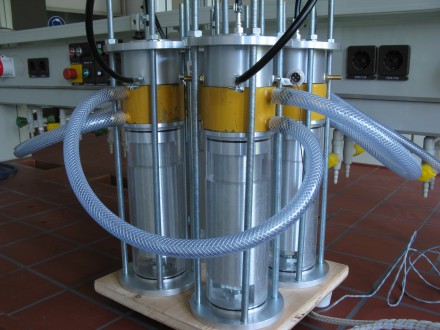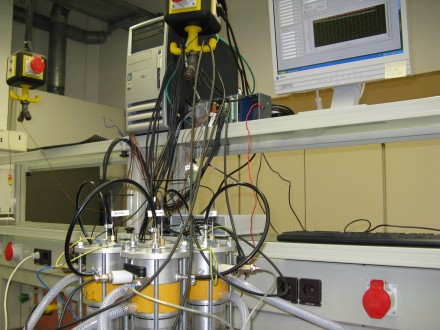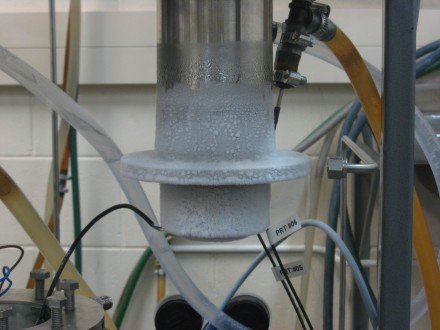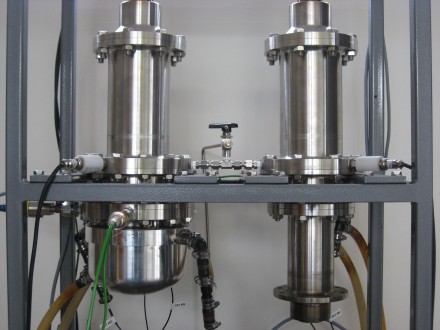Solar cooling
One of our most exciting current projects is with the Fachhochschule Rosenheim (University of Applied Sciences) in Germany. The goal is to develop an inexpensive, highly reliable, efficient, and environmentally-friendly unit that runs on solar power and can be used for air-conditioning or refrigeration in hot and remote areas. The beauty of the concept is that the demand for cooling is normally the highest when the supply of solar power is also the highest. One of the novel aspects of this project is the use of liquid pistons which offers a variety of compelling design advantages. At the same time, however, it is also a great challenge in terms of optimisation. The project is currently funded by the International Mobility Fund of The Royal Society of New Zealand and the Bundesministerium für Bildung und Forschung (International Bureau of the Federal Ministry of Education and Research) Germany.


Low temperature differential Stirling engine
Since 2011 we have been working on the development of a low temperature Stirling engine for geothermal power generation. The project is in conjunction with the University of Canterbury in Christchurch and is sponsored by a large New Zealand electricity provider. We are currently looking at expanding our project to industrial and domestic heat recovery applications.
Cryocooler development
For the past few years we have worked on a Vuilleumier cryocooler for New Zealand's emerging high temperature superconductor (HTS) industry. The concept is radically different to traditional cryocoolers in that it uses a thermal compressor instead of a mechanical one (see Figure). The cycle takes place at constant volume and allows the system to be hermetically sealed much more easily than with a mechanical compressor. Static seals can be used as opposed to sliding seals. This has a significant and often overlooked thermodynamic consequence. Without any sliding seals and a cycle running at constant volume, the mean gas pressure can be kept relatively high which, in turn, results in a higher output performance. This means that for a comparable size the cooling capacity can be increased or, for a comparable output performance, the cycle speed can be reduced which leads to a higher thermal efficiency as flow losses are smaller and more time for heat transfer is available.



With displacers and no pistons in the system another seal issue becomes less severe. In contrast to pistons, displacers have only a small pressure difference across them. This puts less rigorous requirements on the design of displacer seals and facilitates the use of contact-free clearance seals. The only work input that is required is to shift the working gas from one side to the other. Although work is required to overcome fluid friction in the heat exchangers and the regenerator, this is still a lot less mechanical work than in the case of a mechanical compressor.
In comparison with systems using mechanical compressors, the main difference however, is the fact that heat is used as the primary energy input. As a significant advantage, heat can be added to the system in a much higher density on an energy per volume and per weight basis. Consider the physical sizes of a 1 kW-heater element and a compressor providing 1 kW of pressure-volume (p-V) power. Given the trend to significantly larger cooling capacities, thermal compressors have a much higher potential for being scaled up than mechanical compressors. Less vibration and noise are other welcome consequences. Also, the fact that various heat sources can be used in the form of electrical heating or combustion of fuels might be an additional advantage.
The proof of concept has been achieved and we are currently at the stage of improving the performance of the prototype. While there is still some work to do our cooler runs absolutely silently and is almost vibration-free. There are no wearing parts and there is no lubricant. Our vision is to eliminate the need for linear motors completely in one of the next stages.
Heat-actuated heat pumps
In parallel with, but staggered relative to our cryocooler programme, we are working on applying the very same concept to refrigerators and heat pumps at near-ambient temperatures. However, these systems will have an even more radical design that will make them absolutely silent, free of maintenance, and will have no wearing parts. They will be compact, highly adaptable to different applications and relatively cheap to manufacture. This concept has the potential to find its way into domestic refrigerators, heat pumps and dehumidifiers, as well as to solar-powered cooling for air-conditioning units. We are currently in the planning stage of a prototype.
